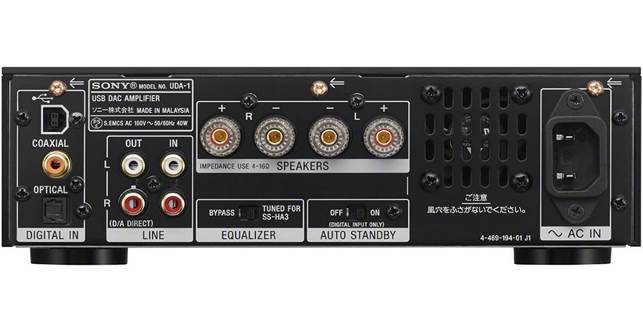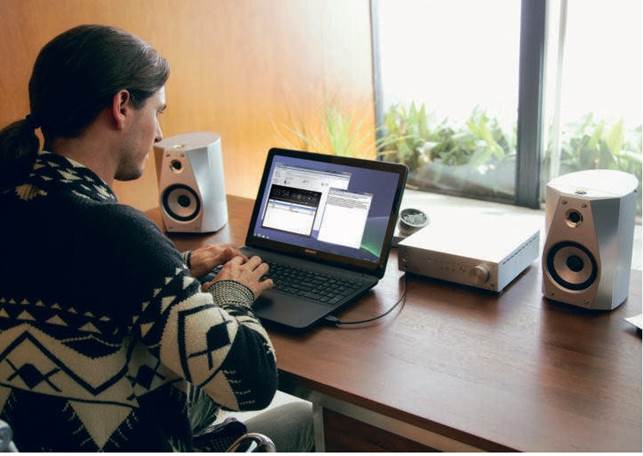Return of the Jedi
Look who’s back. And with a new range of dedicated separates
aimed at bringing hi-res to the audiophile masses, it clearly means business.
Given that Sony is the company that co-created CD’s original Red Book standard
and put the ‘S’ in S/PDIF, it’s safe to assume that its new products will be
based on a legacy of digital audio development.
This new
range is also sensibly streamlined, with a handful of carefully considered
separates spread across distinct product categories. There are the high-end
TA-A1ES integrated amp and HAP-Z1ES media player, each costing $3,316.41 each.
While at the more affordable end of the market sit a couple of Astell&Kern-rivalling hi-res Walkmans
and the UDA-1 you see before you.

The exemplary finish is a timely reminder of
Sony’s glory days
Despite its
meager proportions, the UDA-1 is a versatile little unit that is essentially a
mini integrated with an onboard DAC. It sports a range of digital inputs,
including USB and S/PDIF, shared over coaxial and
optical inputs. There’s also a line-level analogue input, a set of loudspeaker
outputs and a 6.3mm headphone jack, which auto-mutes the speakers when in use.
Add to this a line-level output and you have a great-value starter product that
you can build a system around, as funds allow.
As you’d
expect from the Japanese company that helped give us SACD’s hi-res DSD
protocol, the UDA-1 welcomes the most demanding audio formats. It happily
accepts up to 24-bit/192kHz over its S/PDIF and rear USB socket (its front USB
input is limited to 48kHz) across a range of file
types including WAV, FLAC, ALAC and, naturally, DSD. And for those of us that
dabble in a bit of MP3 streaming for the sake of convenience, the Digital Sound
Enhancement Engine (DSEE) is on hand to help by claiming to restore high
frequencies lost in compression and improving sound quality.
The UDA-1’s
DAC section is based around a finite impulse response (FIR) filter design and
Sony has also specified acoustically tuned capacitors, an EI type transformer
and newly developed carbon resistors for the amp’s internals.

Sony UDA-1 USB DAC Amplifier Connections
At 4kg it
feels brick solid. And the way its 3mm-thick brushed alloy front fascia folds
seamlessly into its top panel looks slick. The few controls adorning its
front-panel are exceptionally well finished for hi-fi kit at any price, and
hark back to Japanese stereo’s glory days. Okay, the side-cheeks are plastic,
but you can’t tell unless you’re up close. As well as a large volume knob,
power and input selector buttons, the front panel also hosts blue LEDs,
denoting your selected input and incoming sample rate, for streams of 88.2kHz and above, although hardcore audiophiles may baulk
at sample rates of 88.2/96 and 176.4/192 being shared over the same LEDs.
Either way, you’ll need good eyesight to see what sampling rate ball park you’re in, as the front panel’s typography is
really quite small.

The UDA-1’s compact design fits neatly into
small spaces
Perhaps to
help keep its dimensions compact, instead of flanks of passive heat sinks, the
Sony comes equipped with an internal fan, which exhausts through its rear
panel. Although I can’t hear the fan in action or feel any vibration when
touching the unit’s casework, I do detect a very slight hum when the Sony is
sat atop a hollow bookcase. Slipping a set of aftermarket sorbothane
feet under its standard tootsies puts pay to this, as does moving it to a
dedicated shelf within my solid oak hi-fi rack.
Setup is
plain simple. Once hooked up to my laptop via USB, I’m prompted to install
Sony’s software, which takes a few seconds. Hitting play in iTunes tells me I’m
connected, as the music begins to flow through my speakers. There’s no fuss or
lengthy manual of tedious set-up configurations to drag yourself
through and once up and running, the credit-card sized remote controller is joy
to use.